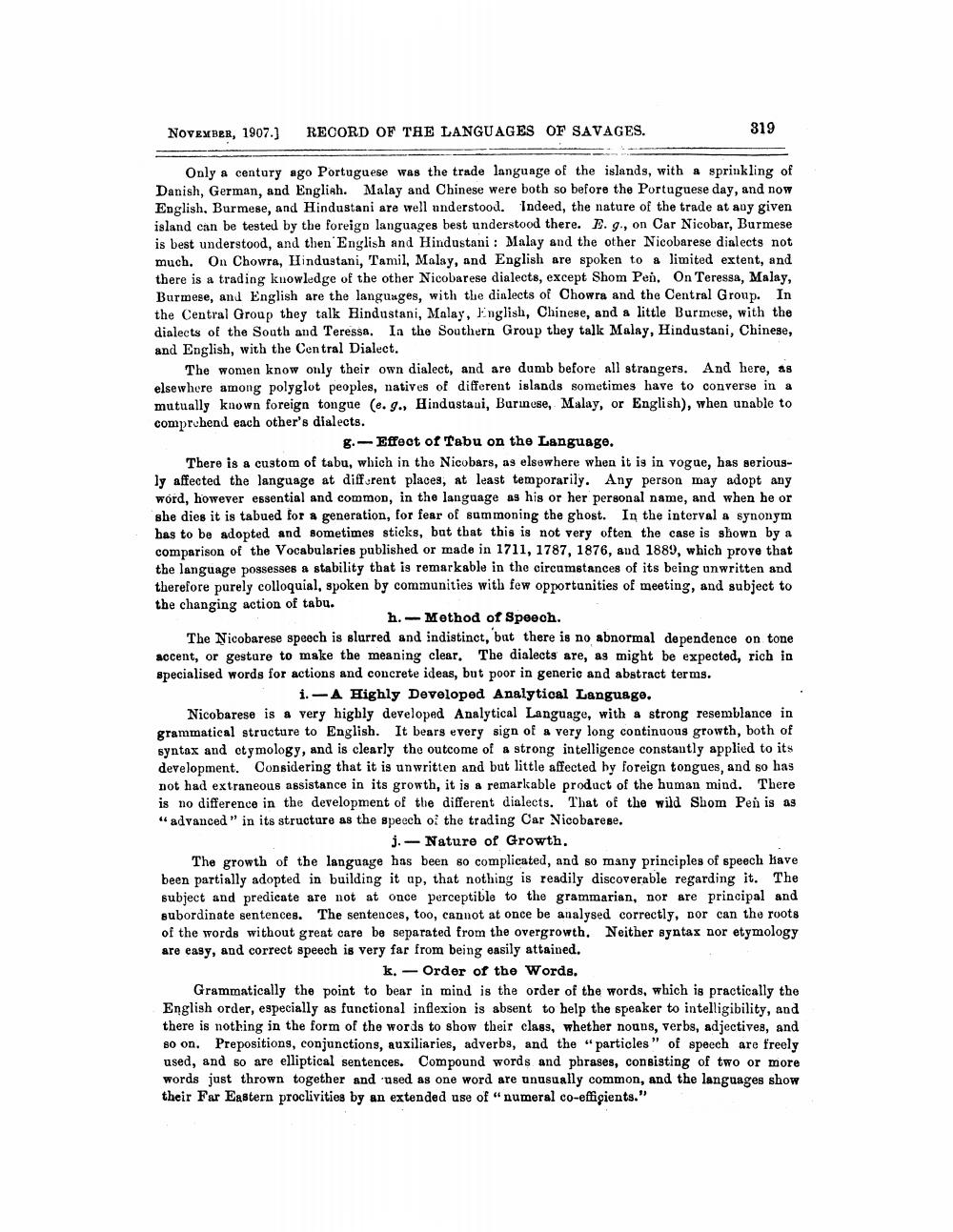________________
November, 1907.)
RECORD OF THE LANGUAGES OF SAVAGES.
319
Only a century ago Portuguese was the trade language of the islands, with a sprinkling of Danish, German, and English. Malay and Chinese were both so before the Portuguese day, and now English, Burmese, and Hindustani are well understood. Indeed, the nature of the trade at any given island can be tested by the foreign languages best understood there. . 9., on Car Nicobar, Burmese is best understood, and then English and Hindustani : Malay and the other Nicobarese dialects not much. On Chowra, Hindustani, Tamil, Malay, and English are spoken to a limited extent, and there is a trading kuowledge of the other Nicobarese dialects, except Shom Pen. On Teresga, Malay, Burmese, and English are the languages, with the dialects of Chowra and the Central Group. In the Central Group they talk Hindustani, Malay, English, Chinese, and a little Burmese, with the dialects of the South and Teressa. In the Southern Group they talk Malay, Hindustani, Chinese, and English, with the Central Dialect.
The women know only their own dialect, and are dumb before all strangers. And here, as elsewhere among polyglot peoples, natives of different islands sometimes have to converse in a mutually known foreign tongue (e. g., Hindustaui, Burinese, Malay, or English), when unable to comprchend each other's dialects.
5.- Effect of Tabu on the Language. There is a custom of tabu, which in the Nicobars, as elsewhere when it is in vogue, has seriously affected the language at different places, at least temporarily. Any person may adopt any word, however essential and common, in the language as his or her personal name, and when he or she dies it is tabued for a generation, for fear of summoning the ghost. In the interval a synonym has to be adopted and sometimes sticks, bat that this is not very often the case is shown by a comparison of the Vocabularies published or made in 1711, 1787, 1876, and 1889, which prove that the language possesses a stability that is remarkable in the circumstances of its being unwritten and therefore purely colloquial, spoken by communities with few opportunities of meeting, and subject to the changing action of tabu.
h. - Method of Speech. The Nicobarese speech is slurred and indistinct, but there is no abnormal dependence on tone accent, or gesture to make the meaning clear. The dialects are, as might be expected, rich in specialised words for actions and concrete ideas, but poor in generic and abstract terms.
i. - A Highly Developed Analytical Language. Nicobarese is a very highly developed Analytical Language, with a strong resemblance in grammatical structure to English. It bears every sign of a very long continuous growth, both of syntax and ctymology, and is clearly the outcome of a strong intelligence constantly applied to its development. Considering that it is unwritten and but little affected by foreign tongues, and so has not had extraneous assistance in its growth, it is a remarkable product of the human mind. There is no difference in the development of the different dialects. That of the wild Shom Pen is as "advanced " in its structure as the speech of the trading Car Nicobarese.
j. - Nature of Growth. The growth of the language has been so complicated, and so many principles of speech kave been partially adopted in building it up, that nothing is readily discoverable regarding it. The subject and predicate are not at once perceptible to the grammarian, nor are principal and subordinate sentences. The sentences, too, cannot at once be analysed correctly, por can the roots of the words without great care be separated from the overgrowth. Neither syntax nor etymology are easy, and correct speech is very far from being easily attained.
k. - Order of the Words. Grammatically the point to bear in mind is the order of the words, which is practically the English order, especially as functional inflexion is absent to help the speaker to intelligibility, and there is nothing in the form of the words to show their class, whether nouns, verbs, adjectives, and so on. Prepositions, conjunctions, auxiliaries, adverbs, and the particles" of speech are freely used, and so are elliptical sentences. Compound words and phrases, consisting of two or more words just thrown together and used as one word are unusually common, and the languages show their Far Eastern proclivities by an extended use of "numeral co-efficients."




